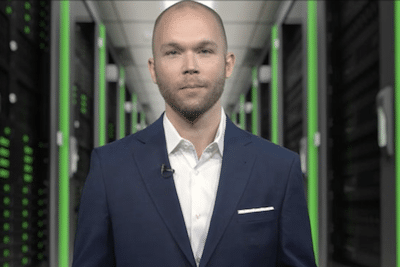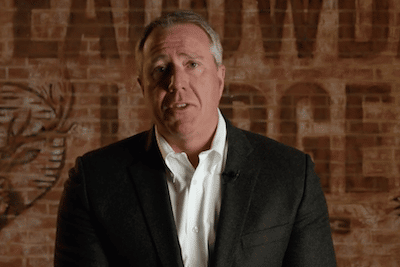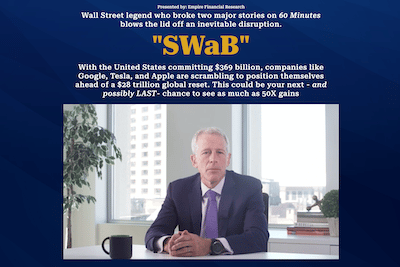I recently came across a presentation featuring Michael Robinson and Bob Keppel of Money Map Press about an “Infinity Chamber,” which the site claims could “create over $8 trillion in new wealth and disrupt every industry on the planet.”
According to the presentation, “the power inside this tiny chamber promises to be game-changing for mankind” and “life-changing for early investors.”
These are some bold claims, for sure. But I wanted to learn more about this so-called “infinity chamber” and what company makes it. So, I decided to look into it further.
And here’s a quick summary of what I found:
- The Infinity Chamber is a high-pressure vacuum chamber designed to “trap” ionized atoms used as quantum bits (qubits), which can perform quantum computations.
- Based on the clues he shares in the presentation, Michael Robinson’s “Infinity Chamber” stock pick is IonQ Inc (ticker: IONQ).
- Michael Robinson shares the details of his stock pick in a report titled “The 100X Quantum Age: The Tiny Startup Launching a Revolution.”
- The only way to access the report is to join Nova-X Report, an investment advisory service he edits for Money Map Press that costs between $79 to $129 per year.
Read on for my complete take on the Infinity Chamber, Michael Robinson’s stock pick, and the Nova-X Report service.
What Is the Infinity Chamber?
If you’re wondering what an “Infinity Chamber” is, you’re not alone.
After going through the presentation, I had many unanswered questions about what this so-called “tiny device” does and why it’s supposedly such a game-changer. So, I did my homework, and in this section, I’ll do my best to break it all down for you.
The first thing I want to point out is that there is no device called an “Infinity Chamber.” This is simply the name Michael Robinson uses when referencing the following “high-pressure vacuum chamber” device:

What does this device do?
The short answer is: the Infinity Chamber (AKA high-pressure vacuum chamber) is designed to “trap” ionized atoms, which are then used as quantum bits (qubits) that can perform quantum computations. So, in other words, it’s a quantum computing device.
How does it work?
The best way to answer that is probably to start with how “regular” computers work. Then, I’ll contrast this to how quantum computers work.
In short, classic computers store information in “bits” coded in ones and zeroes. Essentially, everything you watch, listen to, or read is a sequence of ones and zeroes.
And Michael Robinson likens the way computers solve problems to solving a maze. Like humans, even the world’s fastest supercomputers will explore one path until hitting a dead end and start over again. Which means it can take years to solve complex problems.
However, he explains that a quantum computer doesn’t have these binary limitations because it can analyze trillions of possible outcomes simultaneously.
“So while a classic computer analyzes problems one permutation at a time… a quantum computer can potentially analyze millions, billions, or even trillions of permutations all at the exact same time.”
Why are quantum computers so powerful?
I’m not an expert on quantum computing by any stretch, so I recommend doing your own research on this topic. However, the gist is that a classic “bit” can only be a one OR a zero at any given time, whereas a qubit can be both a one and a zero at the same time. And this allows quantum computers to solve much more complex problems.
Another point Michael Robinson made in the presentation is that an atom is essentially the same as a qubit. This is a complex topic, but it’s central to Robinson’s “Infinity Chamber” recommendation, so I thought I’d elaborate on it real quick.
First and foremost, there are technical explanations of what a qubit is and how qubits relate to atoms, so you might want to check those out to get a more detailed explanation.
However, the general gist is that atoms can be used to produce qubits, which are used in quantum computers. And Robinson explained in the presentation that instead of using synthetic materials to produce qubits, the company he’s teasing uses ytterbium atoms.
“Instead of using synthetic materials, they use naturally occurring real quantum materials. I’m talking about individual atoms. Ytterbium atoms to be exact.”
He also explains that the process his recommended company uses for turning ytterbium atoms into qubits is “where the Infinity Chamber comes into play.”
“Bob: Alright, what’s the process for turning those ytterbium atoms into qubits?”
“Michael: That’s where the Infinity Chamber really comes into play – the Infinity Chamber is actually a high-pressure vacuum chamber.”
So, the Infinity Chamber is what converts atoms into qubits.
And according to Robinson, the “high-pressure vacuum chamber” inside the Infinity Chamber is needed because, for qubits to hold complex quantum information, they must be isolated.
Robinson also explained that there are 100 tiny electrodes in the Infinity Chamber that hold the atoms in place, that the atoms are cooled to negative 459 degrees Fahrenheit inside the chamber, and that lasers are used to manipulate the qubits and prepare them for calculations.
So, to summarize what we’ve learned so far…
The “Infinity Chamber” is a high-pressure vacuum chamber that holds ytterbium atoms in isolation. And with the help of a cooling mechanism and lasers, it converts the atoms into qubits, which are then used for quantum computation.
What’s the big deal?
Michael Robinson lists numerous ways quantum computing (in general) could disrupt multiple industries because the increased computing power could essentially lead to major improvements over how existing systems work.
For example, he talked about how quantum computers could help improve logistics by calculating the optimal route much faster than is currently possible.
According to Robinson, it “would take a classic computer longer than the age of the universe itself” to calculate the optimal route for a UPS driver that makes 135 deliveries a day because there are so many possible routes. Whereas, in contrast, a quantum computer could potentially calculate this in a matter of seconds.
He also talked about how quantum computing could make EV batteries last longer, help reverse climate change, improve medical research, and even help us live longer.
“This breakthrough could finally allow us to combat the biggest problems facing mankind today…”
“I’m talking cancer, climate change, the global water crisis, world hunger. One MIT scientist even believes this breakthrough could extend human life – as well as the quality of life.”
Michael Robinson likens the innovation behind quantum computing as a “radical paradigm shift” which only comes around “once every 50 years or so.”
According to Robinson, the first “major shift” was in the 1870s when oil was discovered. The second was in 1910, when automobiles were invented. The third was the computer revolution. And he believes we are “now leaving the computer revolution and entering the Quantum Age.”
As a result, Robinson says this could unleash over $8 trillion in new wealth and suggests that the “tiny startup” that created the Infinity Chamber is leading the way.
“That’s right – over $8 trillion in new wealth unleashed by quantum computing. And the company leading that charge is the tiny startup that created the Infinity Chamber.”
In the next section, we’ll look at the company that makes the “Infinity Chamber,” and the stock Michael Robinson is teasing.
What Is Michael Robinson’s Infinity Chamber Stock Pick?
Based on the clues Michael Robinson shares in the presentation, I believe the company that created the “Infinity Chamber” is IonQ (ticker: IONQ).
How did I find it? As usual, I took notes of all the main clues shared in the presentation, and after researching several of them, the following clue led me right to it:
“This tiny startup has projected they will hit revenue of $522 million by 2026.”
After Googling “quantum computing company projected to reach $522 million in revenue by 2026,” I found an article on entrepreneur.com about IonQ that confirms Peter Chapman (CEO of IonQ) predicted the company will reach $522 million in revenue by 2026.
From there, I looked into the other clues, and before long, it was clear to me that IonQ was a match. Here’s a summary of why:
- The way Michael Robinson explains how the “Infinity Chamber” works matches what IonQ explains about its “ultra-high vacuum chamber” on the company website. In summary, the company says its “qubits are ionized ytterbium atoms” and that a specialized chip called a linear ion trap featuring 100 tiny electrodes holds it in place. It also explains that the device uses cooling and lasers to function, and it looks very similar to the device Robinson shares in the presentation. So, the device is a match.
- Robinson claims that his recommended company “recently developed the most powerful quantum computer in the world – a 32-qubit masterpiece.” And according to the IonQ website, they are developing a 32-qubit quantum computer.
- According to Michael Robinson, Google, Microsoft, and Amazon “have all formed alliances with this tiny startup” and “are now reselling this tiny startup’s quantum technology through their own cloud services.” And all three companies are shown as “Partner Clouds” on the company website. Robinson also mentions IBM, and it appears as though IonQ and IBM have a partnership related to an open-source development software called Qiskit.
- The information Robinson shares about the CEO (and the image he shares) matches with Peter Chapman, IonQ’s current CEO.
- It’s unclear exactly how many patents IonQ has. However, my research suggests it has filed dozens of patents, some of which are related to quantum computing, quantum mechanics, and quantum information science.
- According to Michael Robinson, the company “began trading days ago,” and an article on hcpwire.com confirms IonQ began trading on October 1, 2021.
- Michael Robinson states that “this tiny startup has annual revenue of a mere $5 million.” And according to quantumcomputingreport.com, IonQ forecasted billings revenue to be about $5 million in 2021 in a recent investor presentation.
So, to sum it up, I believe Michael Robinson’s stock pick is IONQ.
How much does he think the stock could go up? Robinson (more or less) suggests that the stock he’s teasing could go up 500% to 1,000%.
“Bob: So we are talking about a 100-fold revenue surge… With that in mind, it wouldn’t be surprising to see the stock jump 500%–1,000%.”
“Michael: I think that’s right on target – even realistic – given their dominant position, both from a technological standpoint…”
To be clear, Michael Robinson does not specifically mention IonQ in the presentation, but given how closely the clues match, I believe that’s the company he’s referring to.
How do you find out more?
One way to learn more about IonQ as a potential investment would be to read different articles about the company and try to work it out if you think it’s worthwhile.
For example, there’s an article on Seeking Alpha about IonQ that you might find helpful. And there are many others that can be found through a quick Google search.
You could also read Michael Robinson’s report titled “The 100X Quantum Age: The Tiny Startup Launching a Revolution!” This report details his pick and the research he’s done on the company to help you decide if it’s worthwhile or not.
However, the only way to access that report is to join Nova-X for $79. So let’s take a look at what this service is about and how it works to help you decide if it’s worth it.
Recommended: Go here to see my #1 rated stock advisory of 2024
What Is Nova-X Report and How Does It Work?
Nova-X Report is an investment advisory service run by Michael Robinson of Money Map Press focused on five “fast-moving sectors” that he believes have the “potential to grow 100X in the coming decade.”
Each sector represents a “hub” in the member’s area, which provides subscribers with research and investment ideas related to that sector.
Here’s an overview of each hub…
- Quantum Infinity Hub: This “hub” (AKA member’s area section) contains videos, interviews, and research related to quantum computing investments. It also contains the “The 100X Quantum Age” report I mentioned earlier, which details Robinson’s Infinity Chamber stock pick.
- Crypto Hub: According to Robinson, the Crypto Hub is “designed to help folks harness the power of the digital currency movement” and contains a report called “The High-Speed Crypto Sensation Ready to Move Billions,” which details a crypto investment Robinson’s interested in.
- Power Hub: This hub contains a report called “The Maximum Power Titan: 440-Fold Revenue Surge on the Horizon,” which details a company that Robinson says uses artificial intelligence to maximize energy efficiency.
- Digitization Hub: This hub is all about e-commerce related investments and contains a report called “The New Amazon Speeding toward a Trillion-Dollar Business,” which details an online commerce company Robinson is bullish on.
- Biotech Hub: The final hub centers around biotechnology companies Michael Robinson believes could make a good investment, and it contains a report titled “The Universal Vaccine,” which centers around a biotech stock he’s tracking.
So, those are the different “hubs” in the member’s area.
Another feature of the service is the Nova-X Report, a monthly newsletter that details two new investment ideas from Michael Robinson related to the five sectors above.
All in all, the Money Map Press website states that subscribers will receive at least 25 recommendations over 12 months.
Aside from that, Nova-X subscribers get access to “Daily Action Alerts” that keep you updated on what investments Robinson is interested in, inform you of when he suggests exiting one of his recommendations, and break down the week ahead.
The cost of joining the service is either $79, $99, or $129, depending on which membership option you select. And the main difference is what bonus resources you get with your membership (i.e., the $99 and $129 versions come with additional reports).
Who Is Michael Robinson?
According to the Money Map Press website, Michael Robinson is a “37-year veteran of Silicon Valley” who has served as a strategic consultant, board member, and senior advisor to 12 different startups. He’s also the editor of several Money Map Press advisories.
Aside from Nova-X Report, Robinson heads up Nexus-9 Network and Bio-Technology Profit Alliance, which are both higher-end services focused on tech and biotech, Robinson’s specialty. And he edits a free newsletter called Strategic Tech Investor.
Michael Robinson is also a Pulitzer Prize-nominated writer and reporter who’s worked for The New York Times and The Wall Street Journal (among others), and he’s been featured on CNBC and Fox Business over the years.
How have his stock picks worked out? According to Money Map Press, Robinson has “shown folks the opportunity to cash out 17 triple-digit winners” across two of his services.
Of course, that doesn’t mean his Nova-X service will make you money, but Michael Robinson is a real investment expert based on my research.
Bottom Line
The Infinity Chamber presentation centers around a “tiny device” that turns atoms into quantum bits (qubits), which are used by quantum computers, and the “tiny startup” that makes it, which he claims is at the center of “the quantum frenzy.”
Unfortunately, the only way to find out what company he’s teasing and why is to read the “The 100X Quantum Age” report, which comes with a Nova-X Report subscription.
However, after looking into the clues, the company that matches what Michael Robinson talked about in the presentation is IonQ. This company has built a device that converts ionized ytterbium atoms into qubits, which is part of its quantum computer.
Is the Infinity Chamber presentation legit?
It might pay to take the marketing with a pinch of salt, but the Infinity Chamber presentation isn’t a scam. It’s essentially just Michael Robinson sharing his take on a potential opportunity related to quantum computing.
And the Nova-X service is legitimate. It’s backed by Baltimore-based financial publisher Money Map Press and comes with a 60-day money-back guarantee. So the service is legit and could be worthwhile if you’re interested in tech and biotech investments.
However, there’s no guarantee you’ll make money from Michael Robinson’s investment ideas. There’s even a chance you could lose money because there’s risk involved with investing. So just because it’s legit doesn’t mean you’ll see a profit.
Anyway, that’s it from me. I hope you found this post helpful, and I’m keen to hear your thoughts on all of this, so comment below if there’s anything you’d like to add.












M.Robinson has been back on re Carbon Credits ETF covering the EU, California,New England and the u.s. North East.Evidently the Sec make it legal this month for large
companies to disclose their carbon emissions.He’s expecting the etf’s to take off.
Along with the above he came up with 7 stocks with some clues.
Thanks for all your efforts of yourself and team.
See Michael Robinson has a new selection to do with I phone replacement.A holographic phone.Couldn’t bother going thro.the film,so long.I expect there’s a supplier that’s behind his company tip.
You do so well going thro.all those films and analysing the clues.Great effort.